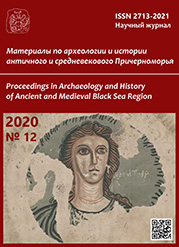Палеопедологические исследования курганов Войцеховского могильника
Paleopedological studies of the Voytsehovka cemetery barrows
Author(s): Zhanna M. Matviishyna, Sergey D. Lysenko, Anatolii S. KushnirSubject(s): Archaeology
Published by: Нижневартовский государственный университет
Keywords: Volyn; Late Trupolye culture; Bronze Age; Trzhinets cultural circle; Komarov culture; burial mounds; paleosoil; subboreal;
Summary/Abstract: The article deals with analysis of paleosoils of the Voytsehovka a cemetery, investigated by the Fastov archaeological expedition in 2011—2012. The most significant materials were obtained from the clearing made in barrows No. 1 and 2. The mounds were erected in the Late Bronze Age and belong to the Komarov culture of the Trzhinets cultural circle (the middle — the 3rd quarter of the 2nd millennium BCE). Trypolye settlement of stage CII (the end of the 4th millennium BCE) preceded time of the building of these kurgans. A gray forest soil was traced in barrow 1 (2011), similar to those that now is forming under broadleaf forests. Climate conditions were much better than modern ones. Zoning (zone of the mixed forest) was placed to the north. Large areas were occupied by hornbeam and beech forests; there were areas of open spaces with lush grass vegetation. The modern soil in the barrow 2 (2012) can be defined as sod-strongly podzolic, but the illuvial horizon with cultural remains may characterize the conditions of forest soil formation, close to the regime of formation of soils of a more warm-temperate regime — brown podzolic forest soils, which developed in conditions of less continental but a more uniformly humid climate. The natural zones represented a westerly version of a warm-temperate climate (similar to the Carpathian one) and, probably, the territory was covered with broad-leaved forests with areas of open spaces. The profile of an older soil is also recorded under the mound, close to podzolic chernozems or dark gray forest soils.
Journal: Материалы по археологии и истории античного и средневекового Причерноморья
- Issue Year: 2020
- Issue No: 12
- Page Range: 13-76
- Page Count: 64
- Language: Russian

